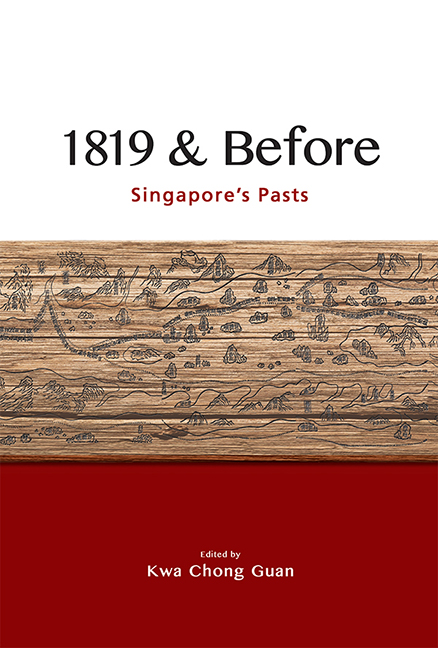Book contents
- Frontmatter
- Contents
- Foreword
- Acknowledgments
- Contributors
- 1 Introduction: Approaches to Singapore’s Past before 1819
- 2 Issues and Approaches to Studying Singapore before 1819
- 3 Regional Influences, International Geopolitics and Environmental Factors in the Rise and Demise of Temasek
- 4 The Mysterious Malay Jong and Other Temasek Shipping
- 5 The Orang Laut and the Negara Selat (Realm of the Straits)
- 6 Avoidance of Shipwreck in the Malay Annals: A Trope in Buddhist Narratives of Maritime Crossings
- 7 The Inception of Lion City
- 8 A Note on Amoghapāśa-Lokeśvara in Singapura
- 9 Portuguese and Dutch Records for Singapore before 1819: An Overview
- 10 Zheng He’s Navigation Methods and His Visit to Longyamen, Singapore
- Bibliography
- Index
6 - Avoidance of Shipwreck in the Malay Annals: A Trope in Buddhist Narratives of Maritime Crossings
Published online by Cambridge University Press: 09 October 2021
- Frontmatter
- Contents
- Foreword
- Acknowledgments
- Contributors
- 1 Introduction: Approaches to Singapore’s Past before 1819
- 2 Issues and Approaches to Studying Singapore before 1819
- 3 Regional Influences, International Geopolitics and Environmental Factors in the Rise and Demise of Temasek
- 4 The Mysterious Malay Jong and Other Temasek Shipping
- 5 The Orang Laut and the Negara Selat (Realm of the Straits)
- 6 Avoidance of Shipwreck in the Malay Annals: A Trope in Buddhist Narratives of Maritime Crossings
- 7 The Inception of Lion City
- 8 A Note on Amoghapāśa-Lokeśvara in Singapura
- 9 Portuguese and Dutch Records for Singapore before 1819: An Overview
- 10 Zheng He’s Navigation Methods and His Visit to Longyamen, Singapore
- Bibliography
- Index
Summary
The Malay Annals narrate how Sri Tribuana, sailing towards the land of Temasek that he espied while out hunting, was caught in a storm that threatened to wreck his ship. The crew could not bale the water out fast enough and the ship was in danger of being wrecked. Sri Tribuana was asked to throw his heavy crown overboard to lighten the ship. This he did, and the storm abated. The symbolism of this avoidance of shipwreck has not been satisfactorily explained. This essay searches for this symbolism of the avoidance of shipwrecks in Buddhist narratives of maritime crossings.
Seafaring Monks in Maritime Asia
The spread of Buddhism from the Indian Subcontinent to Sri Lanka, Southeast Asia and China via the maritime routes goes back at least to the early centuries of the current era. Historical evidence records a steady traffic of monks travelling both eastwards and westwards along the sea routes linking the swathe of territory between the Indian Subcontinent and Japan. Written and material evidence becomes substantial from the fifth century onwards, testifying to an efflorescence of long-distance maritime contacts across Maritime Asia. This vast geographical expanse of sea and land, largely coinciding with a trans-regional “Buddhist Cosmopolis”, became the natural theatre for the journeys of hundreds of travelling monks who crossed the seas far and wide in search of texts, teachers and patrons. The vehicles of their travels were the Monsoondriven merchant ships that plied the maritime routes connecting a web of entrepôts linking the Indian Ocean to the China Sea, carrying— alongside their valuable cargos—pilgrims, diplomats and religious personalities of disparate affiliations.
Most of the monks travelling in both directions between India and China preferred the maritime route to the overland one, or at least sought to include a maritime leg in their journey, which usually included stopovers in Sri Lanka and the Malay-Indonesian Archipelago. Maritime mobility of Buddhist agents, besides being numerically significant, was also quicker and easier than hitherto assumed. In spite of this, both the Jataka tales and the Sino-Japanese and Tibetan biographies of monks travelling from China to India or vice-versa make clear that travel across the maritime trading channels linking the two regions was not devoid of perils.
- Type
- Chapter
- Information
- 1819 & BeforeSingapore's Pasts, pp. 55 - 64Publisher: ISEAS–Yusof Ishak InstitutePrint publication year: 2021



